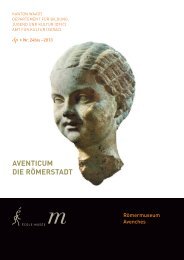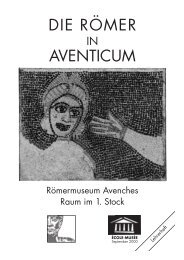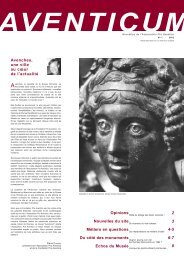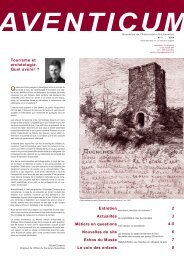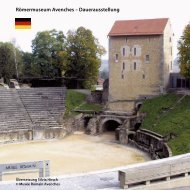Avenches – Roman Museum – Permanent Exhibition
Avenches – Roman Museum – Permanent Exhibition
Avenches – Roman Museum – Permanent Exhibition
You also want an ePaper? Increase the reach of your titles
YUMPU automatically turns print PDFs into web optimized ePapers that Google loves.
Ground Floor <strong>–</strong> Introduction<br />
the so-called Alpine Provinces, and Geneva was part of Gallia Narbonensis. The<br />
midlands between the Jura Mountains and the Alps (the territory of the Helvetii) as<br />
well as the region around Basle (the territory of the Rauraci) were initially attached<br />
to Belgica and then to Germania Superior.<br />
An important network of roads criss-crossed what is now Switzerland: a major<br />
route led from south to north via the St. Bernard pass and the passes in the Grisons<br />
while another arterial road connected western and eastern parts. In addition,<br />
there were navigable waterways from the Lakes of Neuchâtel and Morat via the<br />
Rhine towards the North Sea and from the Lake of Geneva via the Rhone to the<br />
Mediterranean. These different transport axes were used for moving troops,<br />
transporting civilians as well as for short and long distance trade exchanges.<br />
During the 1st century AD, a legion, i.e. 6’000 soldiers and auxiliary troops, was<br />
stationed at Vindonissa (Windisch, Canton Argovia).<br />
Urban settlements were a new development. Examples of such urban<br />
settlements were Nyon (Colonia Iulia Equestris), Augst (Augusta Raurica) (1),<br />
Martigny (Octodurus / Forum Claudii Vallensium) and <strong>Avenches</strong> (Aventicum). Smaller<br />
towns were dependent on these cities and a variety of farms and rural settlements,<br />
in turn, depended on these smaller towns.<br />
Masonry was another innovation introduced by the <strong>Roman</strong>s. While initially, this<br />
technique was reserved for public buildings, it gradually became more popular for<br />
private buildings both in urban and rural settings.<br />
The regional economy was mainly based on agriculture, but various specialised<br />
skills and crafts developed simultaneously, sometimes even reaching an industrial<br />
scale. The incorporation into a vast trading network resulted in many products that<br />
had been unknown until then being imported such as foodstuffs like olive oil, fish<br />
sauces, dates and oysters.<br />
Chronology of Events<br />
753 BC Founding of the City of Rome (2)<br />
509 BC Founding of the <strong>Roman</strong> Republic<br />
3 rd <strong>–</strong> 1 st centuries BC Expansion of the <strong>Roman</strong> Empire (Italian Peninsula,<br />
Iberian Peninsula, Greece, parts of Asia Minor and North<br />
Africa).<br />
58 BC Unsuccessful exodus of the Helvetii and battle against<br />
Julius Caesar at Bibracte<br />
58 <strong>–</strong> 51 BC <strong>Roman</strong> conquest of Gaul<br />
27 BC Beginning of the Imperial period<br />
27 BC <strong>–</strong> AD 14 Reign of Augustus (3)<br />
25 BC Opening of the Great St. Bernard route<br />
16 / 15 BC Subjugation of the Alpine regions<br />
1<br />
Augusta Raurica (Augst)<br />
M. Schaub, Römermuseum Augst<br />
2<br />
3<br />
Chronology of Events<br />
5<br />
Ground Floor<br />
Introduction



